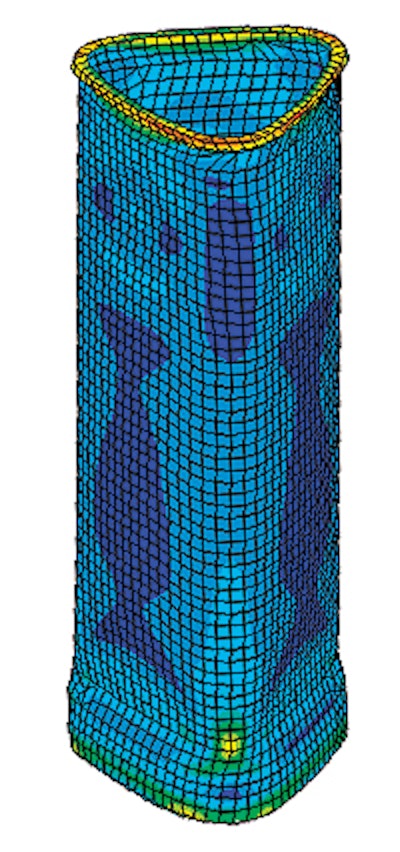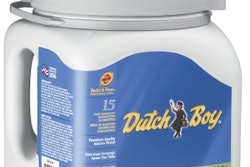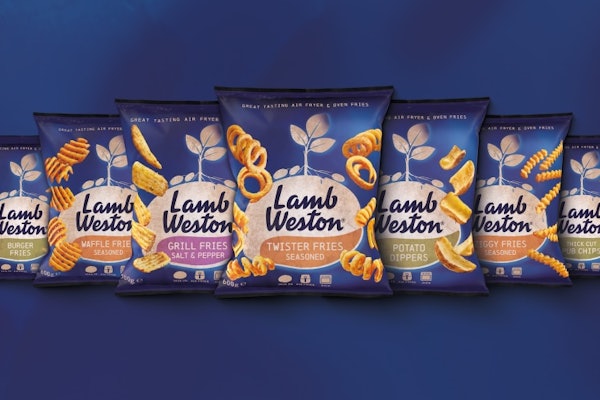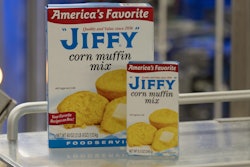Machines that are smart, fluid, and so versatile they’ll permit changeover in the blink of an eye. Plastic bottles with improved barrier. More functional closures. Virtual package design programs that will quicken speed to market. Vastly improved handling and analysis of information.
According to a wide variety of packaging experts (see Pipeline, page 264), these are among the key drivers that will influence the technology of packaging in the future. In some areas, today’s approaches will have to be completely reshaped to meet emerging needs. Equipment design and manufacturing is a good example.
“The manufacturing systems we are familiar with were designed around the needs of mass production and are wholly unsuited to our current demands,” said technology specialist Ian Haynes of Astrazeneca-England at The Future of Packaging, a June conference in Barcelona organized by Pira International and the Faraday Packaging Partner-ship. “High-speed integrated blister lines, up until recently the norm, are being replaced with medium- and low-speed lines offering much greater flexibility. For the smallest batch sizes, we have abandoned integrated lines completely, and we’re questioning hard the benefits of integrated medium-sized lines.”
Succeeding in a business environment where short runs are the order of the day requires “complementary and adaptable manufacturing systems,” continued Haynes. “What will these new machines be like? They’ll be modular and reconfigurable throughout their life to adapt to the changing requirements. The trend towards smaller batch sizes must be matched by reducing changeover times ultimately to zero. These ‘digital packaging’ machines will reconfigure themselves on the fly.”
Artificial intelligence
Andrew McDonald, global automation and control manager at Unilever, echoed Haynes’ remarks in a recent phone interview with Packaging World.
“We have to develop manufacturing systems that treat change as business as usual,” says McDonald. “We need systems based on principles of artificial intelligence distributed across a network that is self-organizing and non-hierarchical.
“Packaging is at the heart of all this. More and more of what we produce and package goes to convenience stores, pharmacies, and so on. They don’t want a truckload of Dove soap bars. They want a specific pallet of product just for their store. To get the required economies throughout the distribution system, we need pallet loads with the right mix of products arranged in the exact order the retailer requires. That means we have to be able to pack any order at any time, and traditional packaging machinery isn’t made that way. What we need are packaging machines that let us package four cases of Shampoo Variant One followed by six cases of Shampoo Variant Two and so on. This radically changes how we set up our packaging lines. In essence, artificial intelligence needs to be embedded within the packaging machinery, and the machinery must be multifunctional rather than single-functional.”
How about packaging equipment with so much intelligence it knows who is allowed to operate it and who isn’t? That’s what Ben Miyares, vice president of industry relations at the Packaging Machinery Manufacturers Institute and president of the Packaging Education Forum, foresees. “I believe we’re close to the day when a piece of packaging machinery will have biometric monitors on it so that only those operators who are qualified will be able to operate it,” predicted Miyares in a recent phone interview.
“Machines will be far more intelligent, too, to the point where they won’t permit ‘tweaking’ beyond pre-set specs,” Miyares continued. “And equipment will be networked not only within a corporation’s multiple facilities but also with the supplier community. That will permit, over the Internet, remote diagnostics and preventive maintenance.”
New materials, too
New developments in packaging materials will also shape the future of packaging. Take closures, for example. One industry insider, who chooses not to be identified, predicts the development of a plastic barrier threaded closure capable of delivering a hermetic seal so secure that inner foil membranes can be eliminated on food and beverage products aseptically packaged in plastic bottles. The chief benefit of such a closure: better line speeds than are currently achieved when an inner membrane must be applied.
Barrier plastic bottles are also bound to benefit from technology advancements in the future. Consultant Gordon Bockner, president of Business Development Associates, predicts an evolution of sorts.
“I think coatings will begin to edge out multilayer structures in the PET arena because they lend themselves to recycling more readily than multilayer structures,” Bockner tells PW. “But the holy grail of barrier bottle development is a new material that will permit a monolayer bottle with no coating. Unlike PEN, which attracted so much attention a few years ago, it’ll be a drop-in material that won’t require any significant changes in injection-molding of preforms or blowing of preforms into bottles. I don’t know if it will be a brand new resin or a blend. But I do know a lot of work is being done in this area, and if we don’t see it in the next two or three years, I guarantee we will in the next five to ten.”
PMMI’s Ben Miyares also has an opinion or two on rigid plastic containers.
“I think we’ll see a lot of them replaced by flexible packaging in food, beverage, and pharmaceuticals,” says Miyares. “In fact, I predict that in 10 years the term ‘bottled water’ will seem quaint. Potable water will be sold primarily in flexible pouches. The PET bottle is only a transitional package in some categories. Convenience and reduction in materials usage will lead beverage marketers to flexibles instead.”
Active packaging—materials that sense environmental change and respond by changing their properties to protect product quality and extend shelf life—is another materials technology poised for significant growth. A recent study by food technologist and packaging hall-of-famer Dr. Aaron Brody forecasts a 19% compound annual growth rate in active packaging in the United States for the next five years (see Chart 1). While only about 2.9 billion packages used an active packaging technology in the United States in 2001, 7 billion units will be used by the year 2006, according to the Brody study. (Published by Packaging Strategies, the study is available for $3귔.)
What about future uses of packaging materials that are driven not by new technologies as much as by clever borrowing? Such borrowings are anything but new in the world of packaging, and it seems safe to predict that they’ll continue into the future. A recent example is the June launch by Finnish fashion house Marimekko of a line of classic shirts in a package format that’s ubiquitous for frozen food products but rarely thought of for clothing: paperboard trays. The thermoformed trays are based on Trayforma FTP board from Stora Enso. The pure SBS board was created specifically for nonfood applications.
“People like to give gifts that have been beautifully wrapped,” says Kirsti Paakkanen, Marimekko president. “This type of product display functions as an effective way of providing product information and makes better brand differentiation possible.”
Package design in the future
The art and science of package development is sure to get a boost from new technologies that let designers predict a package’s performance characteristics without having to waste time making a physical prototype. Essentially these technologies employ computer-aided systems that substitute virtual prototypes for those traditionally made of wood, plastic, or clay.
Among those already using such predictive modeling technologies in the packaging field is General Motors North America Containerization. At Michigan State University’s Worldpak Conference, held last June by MSU’s School of Packaging, GM NAC engineer H.T. Tom Su described how this technology reduces shipping environment variations, improves auto parts shipability, reduces variations in the packaging design process, reduces container fabrication variations, and validates package performance—all as an integrated process.
“Through the advances in Information Technology (IT), Computer-Aided Design (CAD), and Computer-Aided Engineering (CAE), the process integration becomes not only feasible but also more efficient,” said Su at Worldpak. “IT technology enables the collected data to be saved and analyzed in the database for decision-making. Using the results of the analysis to improve container design will make the design more effective and the container more robust.”
The benefits of predictive modeling technology won’t be limited to auto parts packaging. Also at the Worldpak conference, Harold F. Miller of Johnson & Johnson USA had this to say.
“Speed to market is essential for financial success. The days of ‘let’s try it’ are gone. We must know before the first line trial that it will work. We need to be able to predict success, [so] predictive performance modeling needs to be easier with wider availability and application. The transportation and distribution environments are becoming more and more predictive and documented. So why can’t we predict more performance outcomes rather than waiting until the package design is completed and then testing the final result? Predictive performance modeling needs to be the future of packaging development.”
A glimpse into that future is already available at Procter & Gamble, where commercially available software is used to develop a customized interface to automate the virtual analysis of bottle geometry. P&G calls it the Virtual Packaging System (see image on p.170), and it has now been integrated into the firm’s product design cycle. The use of this technology, developed in partnership with Altair Engineering, brings a significant reduction in the time devoted to design validation and physical prototype testing, thereby shortening the time required to take a new product to market.
At MSU’s Worldpak, P&G’s David Henning and Brian Loudin joined Altair Engineering in a presentation describing VPS and its role in the development of P&G’s Torengos package (see packworld.com/go/c054).
Retailer influence
Pressure from retailers has always shaped packaging to some extent, but new technologies will make their influence stronger than ever in the future. “The level of data and the ability to process it will enable retailers to measure things faster than ever before,” says Richard Pascoe, European category management manager for Procter & Gamble; Pascoe, who was among the speakers at The Future of Packaging in June, talked this summer with PW in a phone interview. “Retailers will share that data with consumer packaged goods companies, and they in turn will have to spend time understanding and analyzing the packaging implications contained in that data.”
Another key trend to watch, says Pascoe, is category proliferation. As retailers try to become purveyors of more than just beans, bread, beef, and beer by adding CDs, sporting goods, and other higher-margin categories, increased pressure on available space in the store is inevitable.
“Brand managers in the future may have to spend a little less energy making their packages large and eye-grabbing and more on making packages space-efficient,” Pascoe predicts.
A prime example of this kind of space efficiency is discussed by Gerard Caron and Carole Refabert of the Scopes consultancy in their recently completed Pack.Vision study. Outlining the latest trends in global packaging, the study was commissioned by the sponsors of Emballage 2002. In the study, Caron and Refabert show a compact paperboard tub of concentrated washing power, sold in Japan by Kao Corp., that occupies 80% less volume than the paperboard package it replaced.
Shelf space isn’t the only issue where retailers will assist in bringing forth new packaging technologies. Consider The Scotts Company’s recent shift in its approach to pilferage prevention on 1-gal bottles of concentrated Roundup weed killer, which retails for about $100/bottle. Until early this year, the firm relied on electronic article surveillance (EAS) labels applied to the back of the bottles. But these were too easily removed. As losses due to shoplifting mounted, the Wal-Marts and Builders Squares of the world threatened to put the Roundup bottles into a security cabinet accessible only with the help of store personnel.
Certain that such a move would greatly reduce sales of its product, Scotts searched the marketplace for technology that would help. The answer: put the EAS tag inside the bottle. It was able to do this thanks to the recent development of the Winged smartseal™ from B&G Plastics. Injection molded of a polystyrene/polypropylene blend, this patented device incorporates an acousto-magnetic EAS tag from Sensormatic and is designed with flexible protruding wings that make it easy to insert yet prevent it from coming out. An encapsulated weight sinks the device to the bottom of the bottle, which facilitates both detection and deactivation at the checkout counter.
“This new technology keeps our product out of the cage and out on the shelf where it belongs,” says Jeff Keyser, director of marketing at Scotts.
RFID to play a role
Although advancements in EAS technologies like the Winged smartseal will provide a welcome dose of in-store security to tomorrow’s retailers, another package security concern is product diversion and counterfeiting. By some estimates, as much as 70% of the drugs sold in developing countries are counterfeit. Radio frequency identification is one technology that could address this problem.
RFID involves the use of a silicon chip/antenna embedded typically in tags or labels. The information contained in the chip can be scanned at any point along the distribution chain. This information can then be forwarded to a central computer so that a package’s location can be determined by anyone who is authorized to know. Astrazeneca’s Karen Jones, packaging projects manager in the UK and a speaker at Pira/Faraday’s The Future of Packaging conference, believes this technology will provide big benefits in the future.
“It solves certain problems of security because it adds a whole new level of traceability and tracking,” Jones tells PW. “It could help prevent counterfeiting in the future.”
Michael McCartney of QLM Consulting is another big believer in the potential for RFID and other package-tracking technologies. McCartney delivered a paper at MSU’s Worldpak conference titled Making the package visible in the integrated supply chain.
“In the next five years you’ll see tracking technologies be able to relay information about where a package is anywhere at any time on a real-time basis,” McCartney tells PW. “With an assist from satellite technology, you’ll be able to ‘ping’ or ‘beam’ a message to a package that says ‘Where are you?’ and the chip in the package will respond. That opens up significant opportunities for cost savings gained through improved, real-time inventory management. It’s going to be huge.”
And so ends this brief and anything but comprehensive glimpse into the future of packaging technology. How many of the predictions made here will prove true? Considering the caliber of the prognosticators, probably most. And soon, too. As Astrazeneca’s Jones puts it, “It’s funny how technologies like this have a way of speeding up. You find you’re there before you know it.”
For more on the Pack.Vision study, see: packworld.com/go/w036


























